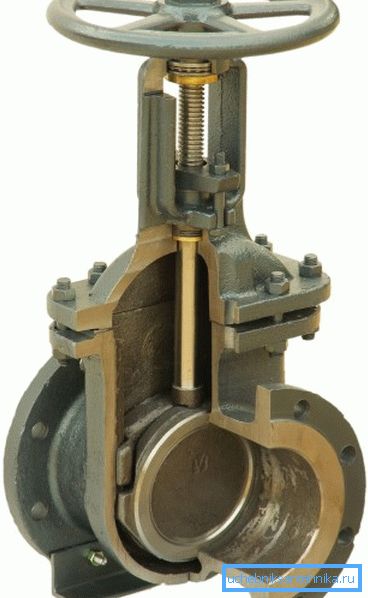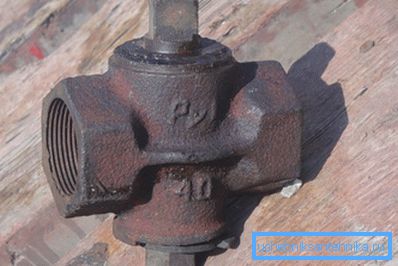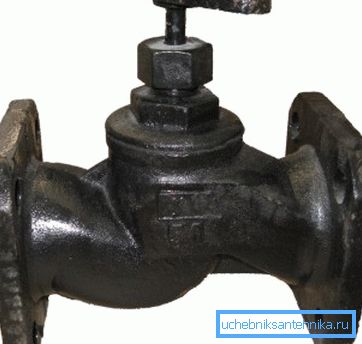Types of cranes: familiar with the classification of valves
What types of sanitary faucets are currently used? In this publication, we will get acquainted with the valves of small and medium sizes, used in water supply and heating systems of private and apartment buildings.

Gate valves
They are used in elevator and water metering units, as well as for cutting off certain sections of large water supply and heating circuits. Typical sizes used within the house - ДУ50 - ДУ100.
However: in elevators of the Stalinok you can rarely find DU150 valves. Even larger sizes are used only on heating lines.
The water in the valve is blocked by a pair of individual cheeks or a monolithic wedge, which is fed into the body with a screw rod. Mirrors (O-rings) on the cheeks (wedge) and the body - metal; sealing is achieved by strong clamping surfaces.
Materials
Here is a list of materials used in the manufacture of valves.
| Element | Material |
| Body, cheeks | Cast iron, carbon steel |
| Stock | Carbon steel |
| Steering wheel | Cast iron, carbon steel |
| Mirrors | Stainless steel, brass |
| Compaction | Graphite gland |
Execution
Gate valves can be classified:
- By way of securing the cheeks against body mirrors. Steel valves are usually completed with a monolithic gate, cast iron - a wedge between two cheeks or between the cheeks and the body.
- The shape of the handle. For cast iron products is characterized by a round wheel, for steel - perpendicular to the rod handle.
- Stock mobility. It can slide out of the case when opened or reside inside the case. In the latter case, the shutter has its own thread.

Characteristic
Advantages of gate valves:
- Relatively low hydraulic resistance.
- Small installation size (smaller than the screw valve of the same diameter).
- Possibility of installation with any direction of water flow.
Disadvantages:
- The need for periodic stuffing gland and grinding the cheeks, which are collected deposits.
- Significant dimensions in the direction perpendicular to the axis of the pipeline (the shutter retracts into the housing, remember?).
- Very moderate tightness of the shutter. The situation when there is no leakage through the control valve in a circular elevator node blocked at all - an exception rather than the rule.
Plug valves
The water is blocked by turning the cork lapped to the body. Tightness is ensured by the almost complete absence of a gap between the plug and the housing. Materials - metals with a relatively small coefficient of friction, not prone to corrosion and sticking to adjacent surfaces to each other: cast iron and brass.
In apartment buildings, valves of 15 - 40 mm in size are used in large quantities.
Execution
In this case, the classification of cranes by type is also possible on several grounds.
- The hull can be modular or monolithic.
- The tightness of the stem of the tube can be ensured by gland packing with a clamping gland or the force of clamping the plug to the body. In the latter case, it is attracted by the nut on the shank passing through the body.

- The valve can be equipped with a handle or overlap with a key.
Characteristic
Advantages:
- The low price associated with the simplicity of the design of the crane.
- A wide enough through channel in traffic, allowing the valve not to clog debris.
Disadvantages:
- At stuffing cranes - constant leaking of the stuffing box when closing and opening, for tensioning cranes - the risk of a liner tearing off.
Note: for stuffing the gland cork valve with his own hands, the pipeline will have to be drained on both sides of it. Otherwise, the disturbed plug may fly out of the hull at the water front.
- Great effort needed to reposition the crane.
- High hydraulic resistance.
Screw valve
The movable valve is driven by a screw rod. He closes the water, clinging to the saddle with a through hole in it. Materials - cast iron (currently, large-sized valves are mainly made from it) and brass.

Execution
What types of taps with a movable valve and a screw rod are used in plumbing:
- The valve can be all-metal, with a polished mirror, or with a gasket of rubber or paronite (again, rubber, only tough and heat-resistant).
- All-metal valve, in turn, may have a flat or conical mirror.
Attention: a variety of taps with a conical brass valve is, in the opinion of the author, the creation of some gloomy genius, sent to plumbers as a punishment for drunkenness. The valve stuck in the housing (and it is stuck very often) cannot be removed without removing the valve completely. The obvious instruction is not to buy this miracle of hostile equipment under any circumstances.
- The stem seal can be made with an oil seal or one or two rubber rings.
Characteristic
Dignity:
- Easy to repair.
Disadvantages:
- The need for packing the gland and the periodic replacement of the gasket (if available).
- High hydraulic resistance.
- Constant accumulation of garbage under the saddle.
- Installation with a single direction of water flow. A counter-flow valve opens when attempting to open a valve.

Ball valves
All types of ball valves represent a deep work on errors in the design of cork valves.
The cork in them is a ball with a through channel equal to the diameter of the pipeline being connected. It is sealed with two low-friction polymer seat rings. As a rule, it seals the stem.
Materials - brass and (less commonly) stainless steel; Teflon or fluoroplastic act as a sealant. Sizes - from DN50 to DU500.
Execution
Different types of ball valves used in the house engineering networks differ primarily in the design and shape of the body.
- The pipeline may be threaded, flanged or welded.
- The body can be collapsible (on the thread or heels) or all-welded.
- The handle can be stationary or removable, in the form of a lever or butterfly.
- The valve can be combined with an arbitrary fitting or coarse filter.
Characteristic
Let us be concise: ball valves do not have any of the above disadvantages. Malfunctions are extremely rare and mostly boil down to the need to preload the seal developed around the stem after several hundred opening-closing cycles.

Conclusion
We hope that our material will help the reader in the selection of valves. The article may seem somewhat biased; However, it is based only on the author’s own experience (see also the article Ball valve 3: 4 - device, characteristics, installation).
As always, the video in this article will offer additional information. Successes!